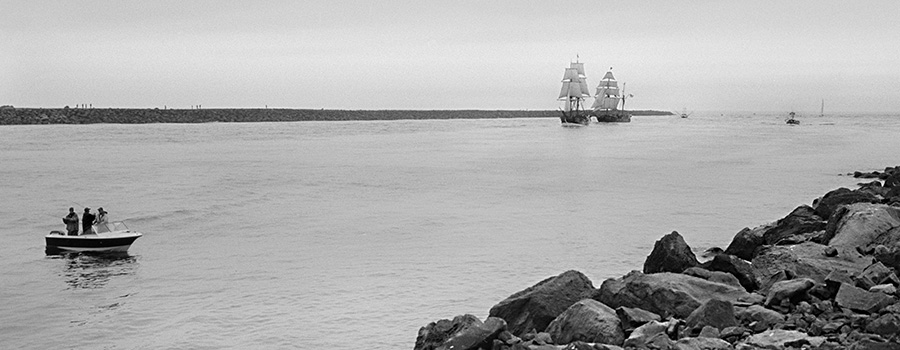|
|
|
|
|
|

|
|
|
|
|
|
Silver gelatin emulsion technology spans more than a century of history. Because silver gelatin was "photography" for so long, there is a wealth of artistic possibilities open to photographers today. Here are the highlights:
|
|
|
|
|
|
Dry Plates
The first silver gelatin negative materials were glass dry plates. Today, dry plate photography is rapidly growing in popularity. More on page 4.
|
|
|
|
|
|
Handmade Film
Handmade film is nothing more than dry plate emulsion coated on polyester film, made for accepting a water-based coating. At this time, Ortho film with an ISO speed up to 100 (summer sunshine) is possible. Panchromatic film is also possible. The handmade "technology" is constantly evolving. More on page 5.
|
|
|
|
|
|
Paper Negatives
Bridging printing paper and negatives are paper negatives. Handmade paper negatives are nothing more than unwashed bromide negative emulsion coated on thin paper. Because the paper texture becomes part of the image structure (more of less, depending on the type of paper), and because the emulsion is slow by film standards, handmade paper negatives are probably best suited for large format cameras. More on page 6.
|
|
|
|
|
|
"P.O.P." (Gelatin Printing-Out Paper)
Gelatin P.O.P. (aka POP) bridged the gap between all the previous printing papers (all printing-out) and faster papers that could be exposed by artificial light. "Printing-out" refers to the fact that the image becomes visible during exposure to strong light; in other words: sunlight. No chemical accelerant/developer is required. Fixing and, optionally, toning need be the only processing steps. Even after developing-out papers were fully in use, P.O.P. remained popular, primarily as studio proofs, but also to print old negatives originally made for the older printing-out processes. Solio was a gelatin POP. More on page 7.
|
|
|
|
|
|
"Gaslight" Silver Chloride Developing-Out Paper
The name "gaslight" comes straight from the paper's place in history. It was the first type of paper that could be exposed by artificial light. At the time, that was gaslight. Turn the gas down low during pre-exposure and processing; crank it up to expose the paper—still necessarily in a contact printing frame. The paper was/is too slow for traditional enlarging. Brands included Azo and Velox. More on page 8.
|
|
|
|
|
|
Bromide Paper
Paper emulsions made with bromide or a combination of bromide and iodide are among the first silver gelatin papers made. They were essentially negative emulsions coated on paper, rather than glass plates. They were the first enlarging papers. In addition, they have a very long and smooth density curve that lends itself to printing with negatives originally made for non-silver printing processes, such as platinum and carbon. In this capacity, bromide paper is useful for photographers who have a stash of dense negatives made for other processes who would like to segue into handmade silver gelatin emulsions without resorting to adapted digital negatives. Brands included Brovira and Royal Bromide. More on page 8.
|
|
|
|
|
|
Slow Chlorobromide Paper
Situated between the very slow chloride papers and the very fast bromide papers are the chlorobromide and bromochloride papers. The ratio of the two halides determines (for the most part) the characteristics of the paper, including most notably speed. Brands included Opal and Kodalure. More on page 8.
|
|
|
|
|
|
Fast Chlorobromide or Bromochloride Paper
These emulsions are made with either nearly equal parts chloride and bromide, or primarily bromide. The faster versions can be used for enlarging. Their characteristic curve is much more suitable for "modern" negatives. Because they are so versatile, they are often considered all-purpose paper. Brands included Kodabromide, Portiga Rapid, and the still-available Ilfobrom Galerie, made by Ilford. If the description of a paper doesn't specify that it is a bromide or chloride paper, it is almost certainly a chlorobromide or bromochloride paper. Almost all currently manufactured papers are. More on page 8.
|
|
|
|
|
|
Creative Potential
Beyond straight printing lies the creative options available to us when we make our own materials. Lith printing, bromoil, and carbro are all processes that require specialty photographic paper, some increasingly hard to source. Gum on handmade silver gelatin is a lovely process. Hand-coloring with pencils requires a paper with a bit of "tooth." If that's commercially available today, I am unaware of it. More on page 9.

|
|
The basic recipes and techniques used to make paper, dry plates, and film can be found in my book, The Light Farm, Handmade Silver Gelatin Emulsions, Dry Plate, Paper, and Film
http://www.blurb.com/b/6465389-the-light-farm
It can be purchased or read for free in Blurb preview. The Light Farm website has additional information.
|
|
|
|
|

|
|
< A Brief History Boiled Down Emulsion Basics >
|



